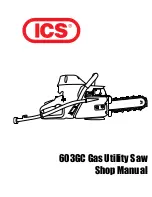
18 ENGLISH
Guide rail
Optional accessory
Place the tool on the rear end of guide rail. Turn two adjust
-
ing screws on the tool base so that the tool slides smoothly
without a clatter. Hold both the front grip and rear handle of
the tool firmly. Turn on the tool and cut the splinter-guard
along the full length with a stroke. Now the edge of the
splinter-guard corresponds to the cutting edge.
►
Fig.32:
1.
Adjusting screws
When bevel cutting with the guide rail, use the slide
lever to prevent the tool from falling over.
Move the slide lever on the tool base in the direction of arrow
so that it engages the undercut groove in the guide rail.
►
Fig.33:
1.
Slide lever
Lanyard (tether strap) connection
Safety warnings specific for use at height
Read all safety warnings and instructions.
Failure
to follow the warnings and instructions may result in
serious injury.
1.
Always keep the tool tethered when working "at
height". Maximum lanyard length is 2 m (6.5 ft).
The maximum permissible fall height for lan-
yard (tether strap) must not exceed 2 m (6.5 ft).
2.
Use only with lanyards appropriate for this tool
type and rated for at least 6.0 kg (13.3 lbs).
3.
Do not anchor the tool lanyard to anything on
your body or on movable components. Anchor
the tool lanyard to a rigid structure that can
withstand the forces of a dropped tool.
4.
Make sure the lanyard is properly secured at
each end prior to use.
5.
Inspect the tool and lanyard before each use
for damage and proper function (including
fabric and stitching). Do not use if damaged or
not functioning properly.
6.
Do not wrap lanyards around or allow them to
come in contact with sharp or rough edges.
7.
Fasten the other end of the lanyard outside the
working area so that a falling tool is held securely.
8.
Attach the lanyard so that the tool will move away
from the operator if it falls.
Dropped tools will swing on
the lanyard, which could cause injury or loss of balance.
9.
Do not use near moving parts or running
machinery.
Failure to do so may result in a crush
or entanglement hazard.
10.
Do not carry the tool by the attachment device
or the lanyard.
11.
Only transfer the tool between your hands
while you are properly balanced.
12.
Do not attach lanyards to the tool in a way that keeps
guards, switches or lock-offs from operating properly.
13.
Avoid getting tangled in the lanyard.
14.
Keep lanyard away from the cutting area of the tool.
15.
Use multi-action and screw gate type carabineers.
Do not use single action spring clip carabineers.
16.
In the event the tool is dropped, it must be tagged
and removed from service, and should be inspected
by a Makita Factory or Authorized Service Center.
►
Fig.34:
1.
Hole for lanyard (tether strap)
WIRELESS ACTIVATION
FUNCTION
For DHS783 only
What you can do with the wireless
activation function
The wireless activation function enables clean and com-
fortable operation. By connecting a supported vacuum
cleaner to the tool, you can run the vacuum cleaner
automatically along with the switch operation of the tool.
►
Fig.35
To use the wireless activation function, prepare following items:
•
A wireless unit (optional accessory)
•
A vacuum cleaner which supports the wireless
activation function
The overview of the wireless activation function setting is
as follows. Refer to each section for detail procedures.
1.
Installing the wireless unit
2.
Tool registration for the vacuum cleaner
3.
Starting the wireless activation function
Installing the wireless unit
Optional accessory
CAUTION:
Place the tool on a flat and stable
surface when installing the wireless unit.
NOTICE:
Clean the dust and dirt on the tool before
installing the wireless unit.
Dust or dirt may cause
malfunction if it comes into the slot of the wireless unit.
NOTICE:
To prevent the malfunction caused by static,
touch a static discharging material, such as a metal part
of the tool, before picking up the wireless unit.
NOTICE:
When installing the wireless unit, always
be sure that the wireless unit is inserted in the cor-
rect direction and the lid is completely closed.
1.
Open the lid on the tool as shown in the figure.
►
Fig.36:
1.
Lid
2.
Insert the wireless unit to the slot and then close
the lid.
When inserting the wireless unit, align the projections
with the recessed portions on the slot.
►
Fig.37:
1.
Wireless unit
2.
Projection
3.
Lid
4.
Recessed portion
When removing the wireless unit, open the lid slowly.
The hooks on the back of the lid will lift the wireless unit
as you pull up the lid.
►
Fig.38:
1.
Wireless unit
2.
Hook
3.
Lid
After removing the wireless unit, keep it in the supplied
case or a static-free container.
NOTICE:
Always use the hooks on the back of
the lid when removing the wireless unit.
If the
hooks do not catch the wireless unit, close the lid
completely and open it slowly again.
Содержание DHS783
Страница 2: ...Fig 1 Fig 2 Fig 3 Fig 4 Fig 5 Fig 6 1 2 3 4 Fig 7 2 ...
Страница 3: ...2 1 1 Fig 8 1 2 Fig 9 2 1 Fig 10 1 Fig 11 1 Fig 12 1 Fig 13 1 0 45 0 48 Fig 14 2 1 Fig 15 3 ...
Страница 4: ...1 Fig 16 Fig 17 1 2 Fig 18 2 1 Fig 19 1 Fig 20 2 1 4 3 Fig 21 1 2 3 4 Fig 22 4 ...
Страница 6: ...Fig 30 1 2 Fig 31 1 Fig 32 1 Fig 33 1 Fig 34 Fig 35 1 Fig 36 6 ...
Страница 7: ...1 3 4 2 Fig 37 2 1 3 Fig 38 1 Fig 39 1 2 2 1 Fig 40 Fig 41 1 Fig 42 7 ...
Страница 8: ...1 2 Fig 43 1 Fig 44 1 Fig 45 1 2 2 1 Fig 46 1 Fig 47 1 1 Fig 48 8 ...
Страница 9: ...2 1 Fig 49 1 B A 2 1 Fig 50 9 ...
















































